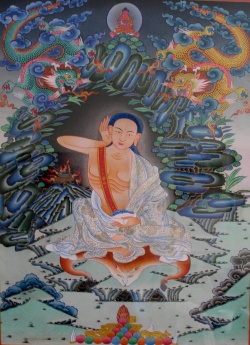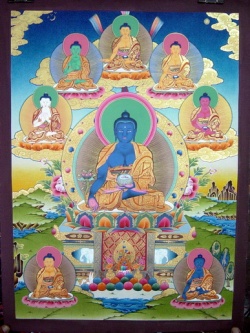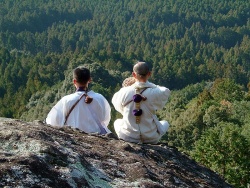Difference between revisions of "Shugendō"
| Line 1: | Line 1: | ||
| − | <nomobile>{{DisplayImages|1248|1477 | + | <nomobile>{{DisplayImages|1248|1477}}</nomobile> |
Latest revision as of 15:10, 1 February 2016
Shugendō (修験道?) is a highly syncretic Buddhist religion or sect and mystical-spiritual tradition that originated in pre-Feudal Japan, in which enlightenment is equated with attaining oneness with the kami (神?).
This perception of experiential "awakening" is obtained through the understanding of the relationship between humanity and nature, centered on an ascetic, mountain-dwelling practice.
The focus or goal of Shugendō is the development of spiritual experience and power. Having backgrounds in mountain worship, Shugendō incorporated beliefs or philosophies from Old Shinto as well as folk animism, and further developed as Taoism and esoteric Buddhism arrived in Japan.
The 7th century ascetic and mystic En no Gyōja is often considered as having first organized Shugendō as a doctrine.
Shugendō literally means "the path of training and testing" or "the way to spiritual power through discipline."
History
With its origins in the solitary hijiri back in the 7th century, shugendō evolved as a sort of amalgamation between Vajrayana, Shinto, and several other religious influences including Taoism.
Buddhism and Shinto were amalgamated in the shinbutsu shūgō, and Kūkai's syncretic view held wide sway up until the end of the Edo period, coexisting with Shinto elements within shugendō.
In 1613 during the Edo period, the Tokugawa Shogunate issued a regulation obliging shugendō temples to either belong to Shingon or Tendai temples.
During the Meiji Restoration, when Shinto was declared an independent state religion separate from Buddhism, shugendō was banned as a superstition not fit for a new, enlightened Japan.
Some shugendō temples converted themselves into various officially approved Shintō denominations.
In modern times, shugendō is practiced mainly by Tendai and Shingon sects, retaining an influence on modern Japanese religion and culture.
Some temples include: Kinpusen-ji in Yoshino (Tendai), Ideha Shrine in Dewa Sanzan, Daigo-ji in Kyoto (Shingon).
Followers
Those who practice shugendō are referred to in two ways.
One term, shugenja (修験者), is derived from the term shugendō, literally meaning "a person of training and testing", i.e. "a person of shugen."
The other term, yamabushi (山伏), means "one who lies in the mountains".
Supernatural creatures often appeared as yamabushi in Japanese myths and folklore, as is evident in tales of the legendary warrior monk Saitō Musashibō Benkei and the deity Sōjōbō, king of the tengu (mountain spirits).
Shugendō practitioners are the most direct lineage descendants of the ancient Kōya Hijiri monks of the eight and ninth centuries.
Modern shugenja in Japan and throughout the world are known to self-actualize their spiritual power in experiential form through challenging and rigorous ritualistic tests of courage and devotion known as shugyō.
Pilgrimages involving mountain treks are embarked upon by shugenja and, through the experience of each trek, as well as years of study, "rank" is earned within the sect.
The rituals are kept secret from the neophyte shugenja and the world at large.
This denju ensures the true faith of the neophytes and maintains the fear of the unknown as they embark upon the austere journey.
This secrecy was also borne out of previous episodes of persecution and oppression of shugenja as a threat to the ruling military hegemony.
Many modern shugenja maintain the practice of relative anonymity in their daily lives.


